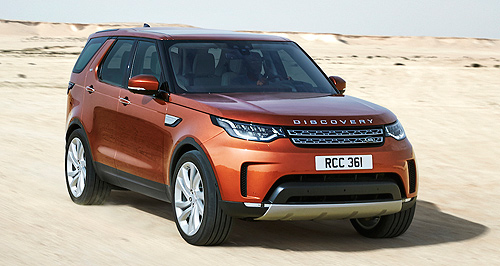New models - Land Rover - DiscoveryParis show: Land Rover winches out DiscoveryDisco moves: The Discovery has lost its original boxy appearance but the new slippery look has resulted in a drag coefficient of just 0.33Cd. Third-generation Land Rover Discovery arriving in July from $81,590 BOCs29 Sep 2016 LAND ROVER has detailed its all new Discovery large SUV at the Paris motor show overnight ahead of an Australian debut in July next year, revealing a lighter, more spacious, efficient and tech-packed version of the family 4WD, but a look that bids farewell to the classic boxy design. With styling that now aligns with the rest of the Land Rover and Range Rover line-up, only the unseen successor to the discontinued Defender has the potential to preserve the angular look, that created an identity for the brand and was once worn by every high-rider in the range. Besides its visual makeover, the 2016 Disco introduces seven seats range-wide, the latest in driver-assistance and passenger comfort technology and the most powerful version of the company’s Ingenium diesel engine to date, but for a price increase of $12,245 over the outgoing base variant. The baseTd4 SE 7 is also powered by the 2.0-litre Ingenium engine albeit with a detuned 132kW/430Nm output as per every other Jaguar and Land Rover model to adopt the four-cylinder with fuel consumption of 6.3L per 100km. Despite the engine downsize from the current 3.0-litre V6 diesel entry-level variant, the Td4 manages the zero to 100km/h dash in two tenths of a second faster at 10.5s thanks to a new advanced aluminium architecture that has stripped out a significant 480kg of weight. With the lighter construction, the new Discovery is more efficient, has a stiffer chassis for improved handling on and off road, and weighs in at 2105kg in its lightest form. The monocoque is made from 43 per cent recycled aluminium. Stepping up to the Sd4 adds an extra turbocharger and pumps power to 177kW and 500Nm – the most grunt wrung from the four-pot since its introduction in the Jaguar XE. With the extra output, the Sd4 accelerates to 100km/h from standstill in 8.3 seconds and can return fuel economy of 6.5L/100km. A six-cylinder diesel is retained for the new-generation Discovery in the form of a 190kW/600Nm V6 that can propel the Landie to 100km/h in 8.1s. No mention is made of a petrol performance halo to succeed the outgoing 3.0-litre supercharged V6 variant. All three engines are bolted to a ZF eight-speed automatic transmission connected to the company’s trademark rotary selector and steering wheel shifters. The unit provides “smooth shifts with sharp responses and optimised fuel efficiency” says Land Rover. Since its introduction in 1989, the Discovery has been known for its capable off-road ability combined with cabin comfort and the British car-maker says the new version will be no different. A class leading set of approach, departure and break-over angles (34, 30, 27.5 respectively), 900mm wading depth and innovative technologies ensure the Discovery is capable of holding its own off-road, while an equal engineering focus has resulted in similarly high levels of on-road comfort for all occupants. Its new suspension system is supported on air bags all round and has double wishbones at the front and an integral link layout at the back. The adjustable layout can be raised up to 75mm for boosted off-road ground clearance, or lowered 60mm from standard ride height for easier access. Ground clearance at standard ride height is 283mm but at speed in excess of 105km/h the suspension automatically drops 13mm to reduce aerodynamic drag and boost cruising fuel economy. The latest generation of Land Rover’s electric power steering, dynamic stability control and Terrain Response 2 electronics have further enhanced the new model’s safety and handling on all terrain. All Discos are equipped with four-wheel drive, but customers will be offered two final drive options including a single speed transfer box for less serious off-road work, with the advantages of a 17kg reduction in weight and improved on-road manners. More adventurous owners can opt for the two-speed transfer box which allows the driver to shift between high and low ranges at speed of up to 60km/h and provides a 50:50 torques split between front and rear axles but uses sensors to share the power around in different proportions depending on the conditions. An update to All-Terrain Progress Control allows a crawl speed of between 2km/h and 30km/h for negotiating particularly challenging terrain, while the Terrain Response 2 Auto system can sense changing surfaces and automatically reconfigures the vehicle for the safest and easiest progress. More experienced Landie drivers can override the system and pick their own Grass, Graven and Snow, Mud and Ruts, Sand or Rock Crawl setting using the centre-mounted dial. A catalogue of clever electronics allows drivers to “deal with any situation confidently and safely” said Land Rover vehicle integrity chief engineer Mike Cross, calling on Hill descent, Gradient Release Control, traction control, Roll Stability Control and a Wade Sensing function, which monitors the maximum safe depth. The new Discovery offers a towing capacity of 3500kg but backs up the hefty maximum with more electronics to assist drivers, including a semi-autonomous Advanced Tow Assist system that takes over the steering when reversing a trailer into a trick parking spot. Another innovative feature allows a lone driver to test trailer lights without another person present to press the brake pedal or activate indicators, while a specially calibrated 360-degree camera can recognise a tow hitch and zoom in as the vehicle nears the point of connection. Once on the move, the Trailer Stability Assist system uses the Discovery stability program to monitor trailer movement and eliminate oscillation or swag before it becomes problematic. Other safety systems include autonomous braking with pedestrian and vehicle detection, adaptive cruise control, hill hold, parking assistance with parallel, exit and perpendicular functions, blind spot monitoring, traffic sign recognition, speed limited, automatic headlights, driver fatigue detection, lane departure warning and assistance. The Discovery’s flexible seven-seat interior can be configured remotely using a smartphone application to tailor the interior space for particular tasks before arriving at the vehicle, such as maximising cabin storage to 2406 litres or 1231L with the second row seats in place. With all seven seats in place, Land Rover says the boot is still versatile at 258 litres and can accommodate a golf bag or three airline cabin carry-on sized bags. Other smaller storage possibilities have been maximised with 2.5 litres of instrument panel storage, 11.7L in the pair of gloveboxes, a total of 13L in front middle and rear centre consoles, a 2.6-litre cubby in the third row and a combined 14.6-litre volume from all four doors. Land Rover’s Activity Key is a clever idea that avoids adventurous owners having to hide their car keys on top of the tyre when enjoying the great outdoors. The special durable bracelet is used to lock and unlock the car while leaving the conventional key inside and can withstand the conditions of outdoor activities such as 30m water submersion and temperature ranges between -50 to 125-degrees. JLR’s InControl Touch Pro has been revised in the Discovery allowing owners to lock and unlock the vehicle with a smartphone, or track the vehicle with an application which will also alert the owner if the car is broken into or moved illegally. The latest system also allows occupants to call for assistance in the event of a collision or breakdown. Up to six 12-volt charging sockets can be optioned around the interior, along with a maximum of seven USB connections or nine if the optional rear-seat entertainment package is specified. Overall, the Discovery is 141mm longer than its predecessor at 4970mm with a 38mm increased wheelbase, but lower and narrower at 1846mm and 2220mm respectively. Despite a softened version of the original Disco’s trademark roofline the new model retains the ‘stadium seating’ allowing second row passengers a better forward view, while comfort is optimised by sliding seating. Heaters can be specified in all seven seats. Customers quick enough to get into Land Rover showrooms can secure an example of just 2400 First Edition launch variants, which add a selection of design and tech features. Limited versions are offered in a choice of Namib Orange, Silicon Silver or Farallon Black with 21-inch wheels and contrasting exterior detailing according to the core colour. The rest of the range will be represented by SE, HSE and HSE Luxury variants but exact Australian range details and pricing is yet to be finalised. Entry-level equipment is highlighted by features such as 19-inch wheels, navigation, leather electric seats, LED headlights, full-size spare wheel and premium sound system. Stepping up to an HSE version adds 20-inch wheels, memory position seats and steering, keyless entry, LED tail-lights, power tailgate, and upgraded sound system, navigation and larger 10-inch touchscreen. Flagship HSE Luxury variants posh leather that covers more surfaces, switchable colour interior lighting, panoramic sunroof, a dusting of chrome-effect trims, front cool box and top spec Meridian sound system and digital TV. A dynamic design pack can be applied to HSE versions for more customisation options.  Read more6th of September 2016  Paris show: Land Rover Discovery fronts upLand Rover provides first look at all-new Discovery before Paris revealAll new models Alfa Romeo Alfa Romeo Abarth Abarth Alpine Alpine Alpina Alpina Audi Audi Aston Martin Aston Martin BMW BMW Bentley Bentley Chery Chery Brabham Brabham Chrysler Chrysler Chevrolet Chevrolet Cupra Cupra Citroen Citroen DS DS Dodge Dodge Fiat Fiat Ferrari Ferrari Foton Foton Ford Ford Great Wall Great Wall FPV FPV Haval Haval GWM GWM Honda Honda Holden Holden Hyundai Hyundai HSV HSV Isuzu Isuzu Infiniti Infiniti Jeep Jeep Jaguar Jaguar Lamborghini Lamborghini Kia Kia LDV LDV Land Rover Land Rover Lotus Lotus Lexus Lexus Maserati Maserati Mahindra Mahindra McLaren McLaren Mazda Mazda Mercedes-Benz Mercedes-Benz Mercedes-AMG Mercedes-AMG Mini Mini MG MG Nissan Nissan Mitsubishi Mitsubishi Pagani Pagani Opel Opel Porsche Porsche Peugeot Peugeot Ram Ram Proton Proton Rolls-Royce Rolls-Royce Renault Renault Saab Saab Rover Rover Smart Smart Skoda Skoda Subaru Subaru SsangYong SsangYong Tesla Tesla Suzuki Suzuki Toyota Toyota Volvo VolvoDiscovery pricing
Motor industry news |
|
















Facebook Twitter Instagram